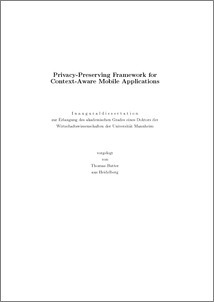|
Privacy-preserving framework for context-aware mobile applications
Butter, Thomas
![[img]](https://madoc.bib.uni-mannheim.de/style/images/fileicons/application_pdf.png)  Vorschau |
|
PDF
diss_final_bib.pdf
- Veröffentlichte Version
Download (3MB)
|
|
URL:
|
https://madoc.bib.uni-mannheim.de/3036
|
|
URN:
|
urn:nbn:de:bsz:180-madoc-30363
|
|
Dokumenttyp:
|
Dissertation
|
|
Erscheinungsjahr:
|
2009
|
|
Titel einer Zeitschrift oder einer Reihe:
|
None
|
|
Ort der Veröffentlichung:
|
Mannheim
|
|
Hochschule:
|
Universität Mannheim
|
|
Gutachter:
|
Heinzl, Armin
|
|
Datum der mündl. Prüfung:
|
30 September 2009
|
|
Sprache der Veröffentlichung:
|
Deutsch
|
|
Einrichtung:
|
Fakultät für Betriebswirtschaftslehre > ABWL u. Wirtschaftsinformatik I (Heinzl 2002-)
|
|
Fachgebiet:
|
330 Wirtschaft
|
|
Normierte Schlagwörter (SWD):
|
Handy , Benutzerprofil
|
|
Freie Schlagwörter (Deutsch):
|
Privatsphäre
|
|
Freie Schlagwörter (Englisch):
|
privacy, mobile, user-interface
|
|
Abstract:
|
In recent years, the pervasiveness of mobile devices, especially mobile phones and personal digital assistants (PDAs), has increased rapidly. At the same time, wireless communication networks have improved considerably and the usage of mobile devices to access the internet is, with decreasing costs, possible almost everywhere and at any time in industrialized countries. However, the usage of mobile technology and mobile applications to support business processes, trans- actions, and personal tasks is still low compared to their potential. The improved capabilities resulted in the introduction of many applications for mobile devices by network operators and software vendors. These services were meant to increase the average revenue per user (ARPU) on top of the voice call income. But many of these services have failed and none of them has led to an improved usage of mobile services today, besides e-mail. A new kind of application, the context-aware application, exploits the ubiquity of the mobile devices in order to fit the personal need or task the user is about to execute satisfactorily. Context-aware systems try to improve the communication with the user by adding information about the current context to the explicit user input and by adapting the output to the current setting of the user. While those applications are seen as important steps to a widespread usage, there are strong factors inhibiting their development and adoption. First of all, the lack of common frameworks handling context data and improv- ing software development increases the cost to build context-aware applications. Each application currently implements its own sensors and logic to handle its data. Furthermore, service providers need to offer tailored services for every con- text of the user. Since no single provider is able to be an expert for all kinds of applications and will not have the necessary number of developers, a common service which finds services of multiple providers for the current situation of the user is needed. All services need to utilize the context attributes which are locally determined by the user’s situation. Development costs are further boosted by the difficulty of developing applications for multiple devices with varying input/output (IO) capabilities like speech output, small and big screens, full qwerty-keyboards, touchscreens, or numeric keypads. From the user’s perspective, privacy also endangers the adoption of mobile services. Context information may include very private data and expose the user’s preferences and habits. While the user may trust a single, well-known, provider to secure the private data and to respect the user’s privacy concerns, the problem increases with more and more smaller service providers.
|
|
Übersetzung des Abstracts:
|
In den vergangenen Jahren wurden Mobiltelefone immer allgegenwärtiger. Gleichzeitig stieg die Kapazität der Kommunikationsnetze und ermöglichte so viele neue Anwendungen. Trotzdem ist die Benutzung mobiler Technologie zur Unterstützung von Geschäftsprozessen im Vergleich zu ihrem Potential noch relativ gering. Eine neue Art von Anwendungen nutzt die Ubiquität des mobilen Endgerätes und ermöglicht so den Kontext des Nutzers zu erfassen. Diese Informationen können genutzt werden, um die Anwendung automatisch an die momentane Aufgabe und Umgebung anzupassen. Während diese Anpassung als wichtiger Schritt für einen weiten Einsatz gesehen werden gibt es Faktoren die deren Entwicklung und Nutzung hemmen. Erstens fehlt ein Framework zur Verarbeitung von Kontextinformationen. Dies führt zu hohen Kosten bei der Entwicklung von Kontextsensoren in jeder einzelnen Anwendung. Weiterhin muss es für beliebige Situationen passende Anwendungen geben. Da diese Dienste nicht von einem einzigen Anbieter zur Verfügung gestellt werden können, bedarf es einer verteilten Dienstsuche über viele Anbieter. Alle Dienste könnten so die gleichen Kontextsensoren nutzen und die Daten auf gleiche Art auswerten. Aus der Sicht der Benutzer führt diese ständige Nutzung der Kontextinformationen zu einer starken Überwachbarkeit durch die Dienstanbieter. Kontextdaten enthalten eine Vielzahl von Daten über die Angewohnheiten und Vorlieben des Nutzers. Die Problematik wird durch die Vielzahl der Dienstanbieter noch verstärkt. Diese Arbeit beschäftigt sich mit einer Architektur für mobile Anwendungen, die den Schutz privater Daten bei gleichzeitiger Nutzung von Kontextinformationen ermöglicht.
(Deutsch)
|
 | Dieser Eintrag ist Teil der Universitätsbibliographie. |
 | Das Dokument wird vom Publikationsserver der Universitätsbibliothek Mannheim bereitgestellt. |
 Suche Autoren in Suche Autoren in
Sie haben einen Fehler gefunden? Teilen Sie uns Ihren Korrekturwunsch bitte hier mit: E-Mail
Actions (login required)
 |
Eintrag anzeigen |
|
|
